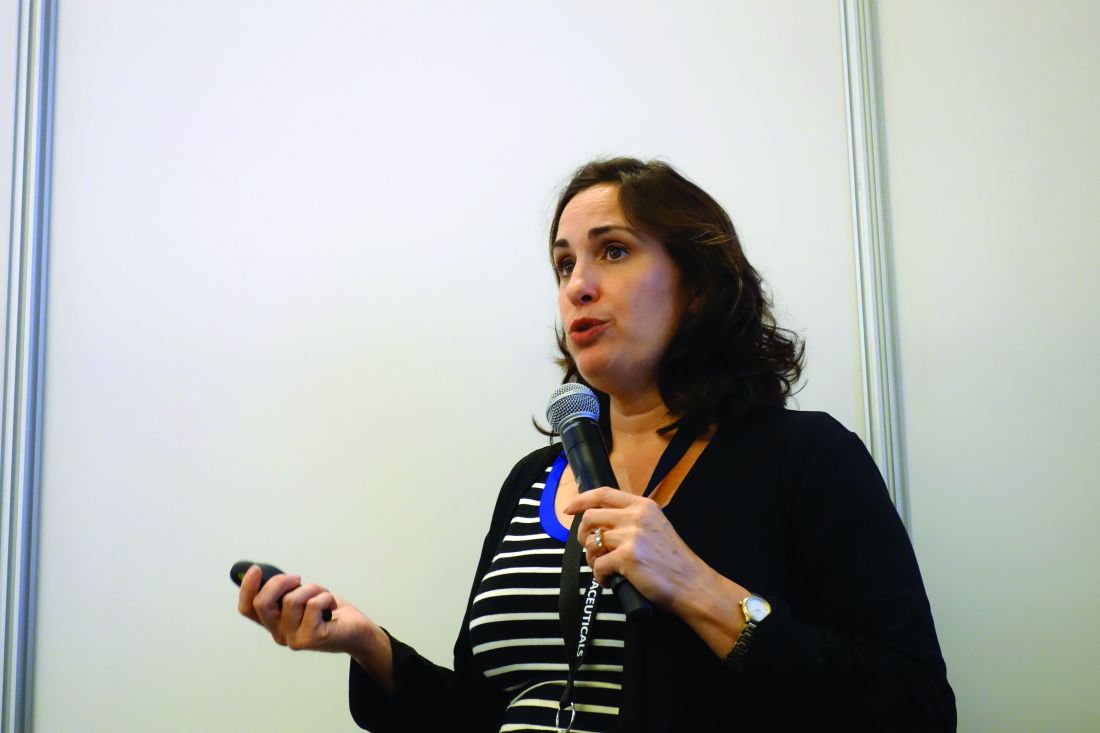User login
PHILADELPHIA – according to an investigation presented at the annual meeting of the American Headache Society.
The largest group of these patients consults primary care physicians. The acute and preventive migraine treatment that these patients receive vary according to the type of provider that they see. Nevertheless, treatment is generally suboptimal, compared with the standards of current guidelines, said the investigators.
Migraine is underdiagnosed and undertreated, said Dawn C. Buse, PhD, clinical professor of neurology at Albert Einstein College of Medicine, New York, and colleagues. Recent changes in health care policy and the expanded array of treatments for migraine warrant an investigation of the current state of migraine care, they added. They examined survey data to understand where patients with migraine in the United States seek care, which characteristics are associated with seeking care in the previous 12 months, and which treatments are prescribed.
Dr. Buse and colleagues analyzed data from the OVERCOME (Observational Survey of the Epidemiology, Treatment, and Care of Migraine) study. These data were obtained in 2018 using a Web-based survey of a representative U.S. sample of 21,143 patients with migraine. The investigators focused on care seeking and medication use in a subsample of 8,844 patients with 4 or more migraine headache days per month to better understand those with the greatest care needs.
The mean age of this subsample was 42.0 years. Approximately 78% of participants were female, and 74.8% were white. In the preceding 12 months, 61.1% of the patients sought care for migraine; 38.3% sought care from more than two types of provider. Provider types included primary care physicians (45.5%), neurologists (20.2%), emergency medicine clinicians (19.2%), urgent care providers (14.4%), pain specialists (12.8%), headache specialists (12.0%), and retail (nonurgent) clinics (10.4%).
Dr. Buse and colleagues found that sociodemographic factors such as age, sex, education, income, and health insurance type influenced participants’ likelihood of seeking care. Seeking care was positively associated with the number of headache days, pain severity, allodynia, aura, and prodrome. When the researchers examined migraine characteristics, they found that nausea and vomiting (68.8%) was more likely to prompt a patient to seek care, compared with phonophobia and photophobia (64.3%). Participants who sought care from a headache specialist (55.0%) or a neurologist (50.1%) were most likely to be using migraine preventive medication. More than 20% of migraineurs seeking care from primary care, urgent care, or retail clinic professionals were undiagnosed.
Primary care doctors were most likely to prescribe triptans, followed by opioids and preventive medications. Neurologists and headache specialists were most likely to prescribe preventive medications and unlikely to prescribe opioids.
Eli Lilly funds the OVERCOME study. Dr. Buse consults for Lilly on this study, but she and her coauthors who do not work in the industry did not receive any funding for any work related to writing, publishing, or presenting any abstracts, posters, platforms, or manuscripts.
PHILADELPHIA – according to an investigation presented at the annual meeting of the American Headache Society.
The largest group of these patients consults primary care physicians. The acute and preventive migraine treatment that these patients receive vary according to the type of provider that they see. Nevertheless, treatment is generally suboptimal, compared with the standards of current guidelines, said the investigators.
Migraine is underdiagnosed and undertreated, said Dawn C. Buse, PhD, clinical professor of neurology at Albert Einstein College of Medicine, New York, and colleagues. Recent changes in health care policy and the expanded array of treatments for migraine warrant an investigation of the current state of migraine care, they added. They examined survey data to understand where patients with migraine in the United States seek care, which characteristics are associated with seeking care in the previous 12 months, and which treatments are prescribed.
Dr. Buse and colleagues analyzed data from the OVERCOME (Observational Survey of the Epidemiology, Treatment, and Care of Migraine) study. These data were obtained in 2018 using a Web-based survey of a representative U.S. sample of 21,143 patients with migraine. The investigators focused on care seeking and medication use in a subsample of 8,844 patients with 4 or more migraine headache days per month to better understand those with the greatest care needs.
The mean age of this subsample was 42.0 years. Approximately 78% of participants were female, and 74.8% were white. In the preceding 12 months, 61.1% of the patients sought care for migraine; 38.3% sought care from more than two types of provider. Provider types included primary care physicians (45.5%), neurologists (20.2%), emergency medicine clinicians (19.2%), urgent care providers (14.4%), pain specialists (12.8%), headache specialists (12.0%), and retail (nonurgent) clinics (10.4%).
Dr. Buse and colleagues found that sociodemographic factors such as age, sex, education, income, and health insurance type influenced participants’ likelihood of seeking care. Seeking care was positively associated with the number of headache days, pain severity, allodynia, aura, and prodrome. When the researchers examined migraine characteristics, they found that nausea and vomiting (68.8%) was more likely to prompt a patient to seek care, compared with phonophobia and photophobia (64.3%). Participants who sought care from a headache specialist (55.0%) or a neurologist (50.1%) were most likely to be using migraine preventive medication. More than 20% of migraineurs seeking care from primary care, urgent care, or retail clinic professionals were undiagnosed.
Primary care doctors were most likely to prescribe triptans, followed by opioids and preventive medications. Neurologists and headache specialists were most likely to prescribe preventive medications and unlikely to prescribe opioids.
Eli Lilly funds the OVERCOME study. Dr. Buse consults for Lilly on this study, but she and her coauthors who do not work in the industry did not receive any funding for any work related to writing, publishing, or presenting any abstracts, posters, platforms, or manuscripts.
PHILADELPHIA – according to an investigation presented at the annual meeting of the American Headache Society.
The largest group of these patients consults primary care physicians. The acute and preventive migraine treatment that these patients receive vary according to the type of provider that they see. Nevertheless, treatment is generally suboptimal, compared with the standards of current guidelines, said the investigators.
Migraine is underdiagnosed and undertreated, said Dawn C. Buse, PhD, clinical professor of neurology at Albert Einstein College of Medicine, New York, and colleagues. Recent changes in health care policy and the expanded array of treatments for migraine warrant an investigation of the current state of migraine care, they added. They examined survey data to understand where patients with migraine in the United States seek care, which characteristics are associated with seeking care in the previous 12 months, and which treatments are prescribed.
Dr. Buse and colleagues analyzed data from the OVERCOME (Observational Survey of the Epidemiology, Treatment, and Care of Migraine) study. These data were obtained in 2018 using a Web-based survey of a representative U.S. sample of 21,143 patients with migraine. The investigators focused on care seeking and medication use in a subsample of 8,844 patients with 4 or more migraine headache days per month to better understand those with the greatest care needs.
The mean age of this subsample was 42.0 years. Approximately 78% of participants were female, and 74.8% were white. In the preceding 12 months, 61.1% of the patients sought care for migraine; 38.3% sought care from more than two types of provider. Provider types included primary care physicians (45.5%), neurologists (20.2%), emergency medicine clinicians (19.2%), urgent care providers (14.4%), pain specialists (12.8%), headache specialists (12.0%), and retail (nonurgent) clinics (10.4%).
Dr. Buse and colleagues found that sociodemographic factors such as age, sex, education, income, and health insurance type influenced participants’ likelihood of seeking care. Seeking care was positively associated with the number of headache days, pain severity, allodynia, aura, and prodrome. When the researchers examined migraine characteristics, they found that nausea and vomiting (68.8%) was more likely to prompt a patient to seek care, compared with phonophobia and photophobia (64.3%). Participants who sought care from a headache specialist (55.0%) or a neurologist (50.1%) were most likely to be using migraine preventive medication. More than 20% of migraineurs seeking care from primary care, urgent care, or retail clinic professionals were undiagnosed.
Primary care doctors were most likely to prescribe triptans, followed by opioids and preventive medications. Neurologists and headache specialists were most likely to prescribe preventive medications and unlikely to prescribe opioids.
Eli Lilly funds the OVERCOME study. Dr. Buse consults for Lilly on this study, but she and her coauthors who do not work in the industry did not receive any funding for any work related to writing, publishing, or presenting any abstracts, posters, platforms, or manuscripts.
REPORTING FROM AHS 2019

